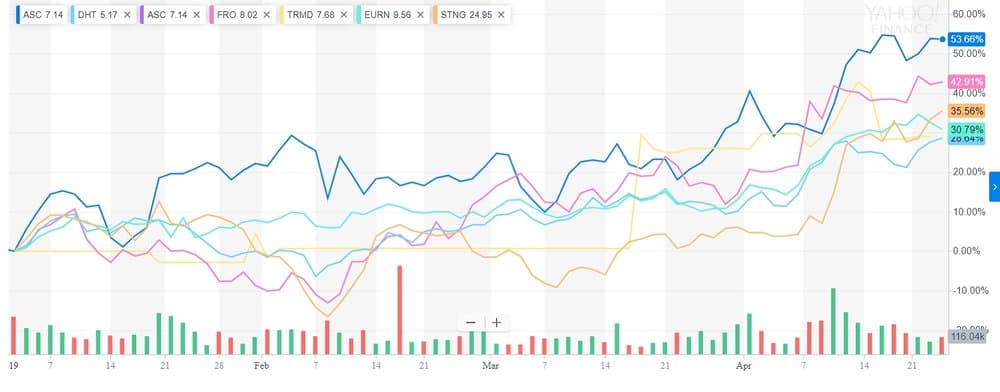After a three-year slide in 2015-18, U.S.-listed tanker stocks have rallied sharply off their lows during the first four months of 2019. At least some investors are betting that the recovery in charter rates is just around the corner, despite repeated false starts over the past half-decade.
Between market close on January 2 and April 24, the share price of Ardmore Shipping (NYSE: ASC) rose by 54 percent, Frontline (NYSE: FRO) by 43 percent, Scorpio Tankers (NYSE: STNG) by 36 percent, Euronav (NYSE: EURN) and Torm (NASDAQ: TRMD) by 31 percent each, and DHT (NYSE: DHT) by 30 percent. The stock of Diamond S Shipping (NYSE: DSSI) has risen 20 percent between the date of its direct listing on March 28 and market close on April 24.
Jon Chappell, shipping analyst at investment bank Evercore ISI, believes this is the start of something bigger. “The long-awaited tanker upturn is here,” he said in a client note, asserting that it’s “time to get long.”
Chappell continued, “Far from an anomaly, this is a true cyclical inflection point with a catalyst kicker.” He noted that the crude and product tanker sectors have just seen their last major spike of newbuilding deliveries before a relative lull, while land-based petroleum inventories have declined.
The ‘catalyst kicker’ he refers to is the fuel-sulfur cap that goes into effect on January 1, 2020, which is expected to hike demand for both crude and product tankers. Chappell predicted that the new rule will provide “material benefits to ton-mile demand across all segments given the likely dislocation of compliant fuel at the outset and the likely arbitrage opportunities associated with providing the right type of crude to different global refining centers.”
“Although investors may have missed some of the low-hanging fruit…plenty of juicy upside remains”
In other words, crude and refined-product supplies will not be where the shipping industry needs them to be to fuel its vessels, and tankers will have to move those supplies longer distances to match them with localized demand. Longer voyage distance reduces the effective tanker supply and creates upward pressure on charter rates.
What’s different about the behavior of tanker stocks in 2019 is that they’re rising well before rates have recovered. Chappell had thought investors would be kept on the sidelines by the combination of seasonal weakness in tanker spot rates, Saudi oil production cuts and high first-half tanker newbuilding deliveries. They haven’t been.
“In retrospect, we were too cute with our entry-point timing as the tanker equities have largely shrugged off near-term rate softening and instead are now beginning to reflect the improving market outlook for the coming 18-24 months. The good news is that although investors may have missed some of the low-hanging fruit, we believe the stocks in general still provide substantial upside potential as the market enters the early innings of a true cyclical upturn. Plenty of juicy upside remains.”
According to Jefferies analyst Randy Giveans, “The outlook [for crude tankers] for the first half of the year remains under pressure. That said, we are maintaining our rate forecast of significant rate improvement in the second half and 2020.” Regarding product tankers, Giveans has reduced his first-half rate estimates due to “short-term pressure,” but remains “bullish on rates going into the second half.”
Some of the tanker stocks pared a small amount of their 2019 gains following the U.S. government’s decision to end waivers on purchases of Iranian oil. However, Stifel analyst Ben Nolan believes this decision could end up being a plus for tanker rates.
He estimated that Iran’s exports of 1.1 million barrels/day, primarily to Asia, would require the use of around 30 very large crude carriers (VLCCs), with Iran “almost exclusively using its own ships” for this trade. Because Iran uses its own tankers, the Iran-Asia crude trade is effectively cordoned off from the broader VLCC market.
“Saudi Arabia, Russia and the UAE, all of which are producing under capacity as part of the OPEC+ production cuts, have kindly offered to fill the void left of absent Iranian barrels,” explained Nolan. These replacement supplies will be carried by non-Iranian VLCCs that are a part of the broader market.
“Thus, the net effect would be increased demand for approximately 30 VLCCs from that trio with no negative impact from the displaced Iranian ships. There are 758 VLCC in the global fleet, so adding incremental demand for 30 would translate into a 4 percent improvement,” said Nolan.












JEAN NOEL BRIDIANE
Dear Sir i the Managing Director of JNB DISTRIBUTION LTD from MAURITIUS, willing to have your best qoute for a tanker to transport 2 million barrel of light crude oil from malta port to port klang malaysia.
cordially
JEAN NOEL BRIDIANE